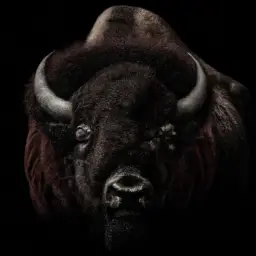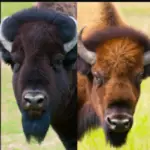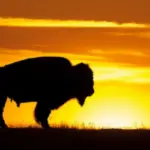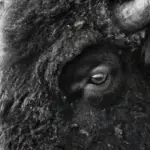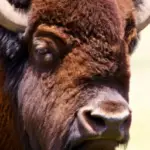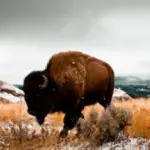Have you ever wondered how bison manage to protect themselves in the wild? The fascinating world of bison defense mechanisms is unveiled in this article. From their massive size to their impressive horns, bison have evolved several ways to defend themselves from predators. Join us as we explore the intriguing ways in which these majestic creatures ensure their safety and survival. Prepare to be amazed by the resilience and resourcefulness of the bison as they navigate their dynamic and challenging environment.
Physical Attributes of Bison
Bison, also known as American buffalo, possess impressive physical attributes that contribute to their defense strategies. First and foremost, their size and strength make them a formidable presence in the animal kingdom. Adult bison can reach heights of up to 6 feet at the shoulder and lengths of up to 10 feet, with males being larger than females. Their massive build, weighing in at around 1,000 to 2,000 pounds, enables them to withstand and deliver powerful blows when threatened.
Size and Strength of Bison
The size and strength of bison provide them with a natural advantage in defense against predators. Their muscular bodies and robust bone structure make it incredibly challenging for predators to successfully take them down. Their large, stocky frames and thick hides act as a protective shield, minimizing the risk of injury during confrontations. Moreover, the sheer mass of bison allows them to exert great force when charging or butting their opponents, further enhancing their defensive capabilities.
Horns of the Bison
One of the most distinctive physical features of bison is their magnificent horns. Both male and female bison possess horns, which can grow up to 2 feet in length and curve outward from their massive heads. These horns are composed of a keratinized sheath that covers a bony core, providing an additional layer of defense. Bison can use their horns as offensive weapons, delivering powerful blows to predators or rival bison during territorial disputes. The horns also serve as a visual deterrent, warning potential threats of their formidable strength.
Speed and Agility
While bison may not possess the speed and agility of some other ungulates, such as cheetahs or antelopes, they are still surprisingly agile for their size. Despite their bulk, bison can reach speeds of up to 35 miles per hour when spurred into action. This impressive burst of speed allows them to outrun most predators, especially over short distances. Additionally, their ability to change direction quickly and maneuver through dense vegetation enables them to elude attackers and find refuge in challenging terrain.
Defensive Posture
When faced with danger, bison adopt various defensive postures to protect themselves and their herd members.
Positioning of Body and Head
A key defensive posture of bison is the positioning of their body and head. When threatened, they will lower their massive heads, bringing their horns into a threatening position. This not only serves as a visual warning to potential predators or rivals, but also prepares them for charging or butting their opponents. Additionally, bison will often stand sideways, presenting a smaller target and making it more difficult for predators to deliver fatal bites to vital areas.
Use of Hooves and Horns
Bison employ their hooves and horns as formidable defensive weapons. When predators or intruders approach, bison will stomp their hooves to create a thunderous sound, signaling their readiness to defend themselves. They can deliver powerful kicks with their sharp hooves, capable of inflicting severe injuries. Additionally, bison will use their horns in a rapid, sweeping motion, aiming to fend off attackers or rival males. The combination of their hooves and horns serves as a potent deterrent and an effective means of defense.
Mobility and Stance when Threatened
Bison’s ability to rapidly change their stance and position is crucial for their defense. When faced with a threat, they have the agility to swiftly change direction and evade attackers. Moreover, bison often form a defensive line, facing their enemies head-on. This united front intimidates predators and showcases their collective strength to potential threats. By remaining mobile and actively engaging in defense, bison increase their chances of survival and protect their herd members.
Herd Defense Strategies
Bison are social animals that form cohesive herds, and their defense strategies are deeply rooted in their herd dynamics.
Bison Protective Circle Formations
One of the most remarkable herd defense strategies employed by bison is the formation of protective circles. When sensing danger, bison will gather closely together, with adults surrounding the more vulnerable young members in the center. This circle formation effectively creates a barrier against predators and increases the overall visibility of the herd. By presenting a united front, bison make it exceedingly challenging for predators to single out individual targets, providing greater protection to the entire herd.
The Role of Male and Female Bison in Defense
Both male and female bison play critical roles in the defense of the herd. Male bison, also known as bulls, are larger and more physically dominant. They actively defend the herd by utilizing their size, strength, and formidable horns. Bulls will charge and confront threats head-on, ensuring the safety of the herd members. Female bison, or cows, also contribute to defense by protecting the young calves within the circle formation. Their maternal instincts and vigilance in safeguarding the vulnerable offspring are essential for the survival of the herd.
Protection of Young Bison
Protecting the young is a top priority for bison herds. Adult bison display remarkable vigilance towards the calves, actively shielding them from potential dangers. As mentioned earlier, the protective circle formation allows the young bison to remain safely in the center, surrounded by adult members. The adults will use their bodies to shield the calves from predators, creating an effective barrier against threats. By prioritizing the safety and protection of their young, bison ensure the continuity of their species.
Bison Aggressiveness
Bison can exhibit aggressive behavior when provoked or threatened, employing various tactics to establish dominance and protect themselves.
Triggers for Bison Aggression
Several factors can trigger bison aggression. One of the primary triggers is the proximity of potential threats or intruders to their herd or personal space. Bison are protective of their territory and resources, so any encroachment on their domain can elicit an aggressive response. Additionally, during the rutting season, when mating competition is fierce, rival males may engage in aggressive confrontations to establish dominance and secure mating opportunities. It is crucial for individuals to recognize and respect the boundaries of bison to prevent triggering their aggression.
Bison Fighting Tactics
When bison engage in aggressive interactions, they employ various fighting tactics to establish dominance. One common tactic is headbutting, in which bison charge at each other and forcefully clash their heads together. This duel determines the hierarchy and social status within the herd. Bison can also employ flanking maneuvers, attempting to attack the weaker sides of their opponents. The intensity of the fights can vary, ranging from minor disputes involving head clashes to more intense battles with horn-locking and shoving matches.
Dominance Displays
Bison employ dominance displays to communicate their superiority and intimidate rivals or predators. These displays involve a combination of visual cues and vocalizations. Dominant bison will often raise their heads high, arch their backs, and visibly flare their nostrils, showcasing their physical strength. This visually imposing posture is accompanied by deep grunts, growls, and snorts, further asserting their dominance. These displays serve as a clear warning to rivals, communicating their capability and unwillingness to back down.
Bison Communication
Effective communication is vital for the survival and coordination of bison herds. Bison employ various methods to communicate with each other.
Auditory Signals
Bison utilize a range of vocalizations to communicate different messages. Deep growls and grunts are often used to assert dominance or express aggression. These low-frequency sounds can be heard over long distances and effectively convey the sender’s intentions. In contrast, high-pitched vocalizations, such as calf calls or alarm calls, alert herd members to potential dangers. These vocal signals enable bison to coordinate their defense strategies and respond collectively to threats.
Visual Displays
Visual displays play a crucial role in bison communication. They use various body postures and movements to convey intentions or assert dominance. As mentioned earlier, the positioning of their head and body during defensive postures serves as a visual warning to predators or rival bison. Additionally, bison employ tail movements to communicate with fellow herd members. A raised tail indicates alertness or aggression, while a relaxed and lowered tail indicates a more calm disposition.
Scent Marking
Scent marking is another means of communication for bison. By rubbing their bodies against trees or rolling in scent-marked areas, they transfer their distinct scent onto the surroundings. This scent acts as a form of territory marking, allowing bison to establish boundaries and communicate ownership to other herds or individuals. Scent marking also plays a crucial role in attracting mates during the breeding season, with males depositing their distinctive odors to signal their availability and dominance.
Predator Specific Defense Mechanisms
Bison have evolved specific defense mechanisms to counter the threats posed by their main predators, such as wolves and large cats.
Defense Against Wolves
Wolves are one of the primary predators of bison, but these formidable herbivores have developed strategies to defend against them. When a pack of wolves targets a bison herd, the adults will gather in a tight defensive formation, placing the calves in the center. This circle, coupled with the powerful kicks and charges of the adult bison, makes it exceedingly difficult for wolves to penetrate the herd. Furthermore, the sheer size and strength of bison can intimidate wolves, often leading to the predators seeking easier prey.
Defense Against Large Cats
While large cats, such as cougars or mountain lions, pose a significant threat to bison, their defensive tactics against them differ from those used against wolves. Bison rely on their sheer size and strength to intimidate these predators. By presenting a united front and demonstrating their formidable physical attributes, bison can deter large cats from launching an attack. Their powerful kicks and sweeping horn movements can also incapacitate or even kill a large cat, making them a risky target.
Bison Behavior Towards Human Threats
Historically, bison were hunted by Native American tribes as a means of sustenance and for cultural purposes. Today, however, bison behavior towards humans has evolved due to the changing dynamics between the two species. Bison generally exhibit caution and wariness towards human presence. When approached, bison will often adopt a defensive stance, lower their heads, or vocalize to display their readiness to defend themselves if necessary. It is crucial for humans to respect the personal space and boundaries of bison, ensuring the safety of both parties.
Role of Bison Fitness in Defense
The fitness of individual bison greatly impacts their ability to effectively defend themselves and their herd members against threats.
The Impact of Health and Age on Defense Capability
Healthy individuals with optimal physical condition are better equipped to engage in defensive behaviors. Bison in peak health exhibit greater strength, agility, and endurance, enabling them to withstand attacks or outmaneuver predators. Furthermore, age plays a crucial role in defense capabilities. Adult bison, especially prime-aged individuals, possess more experience in defending themselves, making them more effective guardians of the herd. Older individuals may still contribute to defense strategies but may be less agile or endure reduced strength.
Implications of Environmental Stresses on Defense
Environmental factors can significantly impact the defense capabilities of bison. Availability of resources, such as food and water, influences their overall health, strength, and endurance. During periods of drought or scarce vegetation, bison may experience nutritional deficiencies that can weaken their physical condition and reduce their ability to defend themselves effectively. Climate extremes, such as harsh winters or heatwaves, can also pose challenges to their survival and defense, as it increases energy expenditure and restricts their movements.
Human Impact on Bison Defense Mechanisms
Human activities have had significant consequences on the defense mechanisms of bison, altering their natural behavior and dynamics.
Consequences of Human Interference
Human interference, such as habitat destruction and fragmentation, has led to bison facing increased vulnerability and reduced spatial range. As their natural habitats shrink, bison are forced into closer proximity with human settlements and infrastructure. This proximity increases the likelihood of conflicts between humans and bison, disrupting their natural defensive behaviors. Bison may become more nervous or defensive towards human presence, potentially leading to heightened aggression or altered defensive strategies.
Impacts of Hunting and Animal Agriculture
Historically, bison populations were decimated due to overhunting and unregulated exploitation, almost leading to their extinction. While conservation efforts have helped reestablish their numbers, hunting and animal agriculture continue to impact their defense mechanisms. Bison raised for agricultural purposes may exhibit altered behaviors due to human intervention and selective breeding. Moreover, hunting can disrupt herd dynamics, remove dominant individuals, and potentially weaken the overall defense capabilities of the population.
Conservation Measures
Given the ecological and cultural significance of bison, conservation measures have been implemented to protect these majestic creatures. Establishing protected areas and national parks has allowed bison to thrive in their natural habitats, limiting human interference and ensuring their security. Additionally, conservation efforts aim to restore and expand bison populations through reintroduction programs and sustainable management practices. By creating suitable environments for bison and educating the public on the importance of their conservation, we can contribute to the preservation of their natural defense mechanisms.
Comparison with other Bovines
When comparing the defense mechanisms of bison to other bovine species, such as cattle, notable differences arise.
Defense Mechanisms of Bison versus Cattle
Unlike bison, domesticated cattle have undergone significant selective breeding and domestication processes, which have led to differences in their defense mechanisms. While cattle also possess size and strength advantages, their instincts for defense may be less honed. Bison, being more closely related to their wild ancestors, exhibit a more instinctive and robust defense response. Additionally, bison are more agile and possess a greater willingness to confront threats head-on, whereas cattle may be more likely to flee when faced with danger.
Comparison with other Wild Bovine Species
Bison are not the only wild bovine species that have developed unique defense mechanisms. Other species, such as African buffalo and gaur, exhibit similar defensive traits and strategies. These wild bovines also rely on their size, strength, and impressive horn structures to deter predators and establish dominance. However, the specific adaptation and effectiveness of their defense mechanisms may vary depending on the species’ ecological niche and evolutionary history.
Does Bison’s Rejection of Their Young Impact Their Defensive Behavior?
The reasons for bison rejecting young remain unclear, but research suggests that this behavior may not directly impact their defensive behavior. Bison are known to be protective of their herd, regardless of whether they have rejected a young calf. Defensive behavior is likely driven by other instincts and factors.
Current Research on Bison Defense Mechanisms
Ongoing research continues to shed light on the intricacies of bison defense mechanisms, with scientists studying their behaviors and responses to threats in greater detail.
Latest Findings on Bison Defense Tactics
Recent studies have expanded our understanding of the intricacies of bison defense tactics. Researchers have delved into the biomechanics of bison charging and fighting, exploring factors such as impact force and damage potential. New technologies, such as high-speed cameras and GPS tracking devices, allow scientists to capture precise data on bison movement patterns during defense. These findings contribute to our knowledge of bison behavior and aid in developing effective conservation strategies.
Ongoing Studies on Bison Behavior and Response to Threats
Ongoing studies focus on examining how bison behavior and response to threats are influenced by various factors, including human presence, habitat disturbances, and climate change. By closely monitoring bison populations and their interactions with their environment, researchers can identify potential vulnerabilities and address emerging challenges affecting their defense mechanisms. These studies provide valuable insights that guide conservation efforts and ensure the long-term survival of bison populations.
In conclusion, bison employ a variety of physical attributes, defensive postures, communication methods, and herd strategies to protect themselves and their herd members. Their size, strength, impressive horns, and defensive behavior have enabled them to survive and thrive in the face of various threats throughout history. However, human impact and environmental pressures continue to impact their defense mechanisms, making conservation efforts crucial for the preservation of these magnificent creatures. Through continued research and effective conservation measures, we can contribute to the resilience and well-being of bison populations worldwide.

